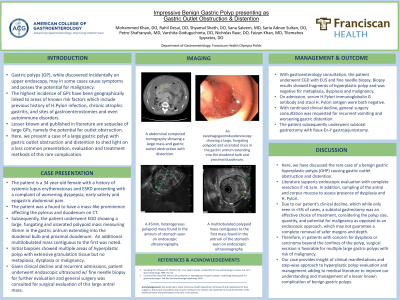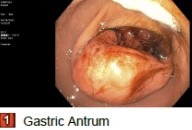Tuesday Poster Session
Category: Stomach
P4198 - Impressive Benign Gastric Polyp Presenting as Gastric Outlet Obstruction and Distention
Tuesday, October 24, 2023
10:30 AM - 4:00 PM PT
Location: Exhibit Hall

Has Audio
- MK
Mohammed A. Khan, MS, DO
Franciscan Health Olympia Fields
Park Forest , IL
Presenting Author(s)
Mohammed A. Khan, MS, DO1, Rahil Desai, DO2, Shyamal Sheth, DO1, Sana Saleem, MD3, Saria Adnan Sultan, DO3, Petro Shafranyuk, MD4, Varshita Goduguchinta, DO1, Faizan Khan, MD4, Nicholas Baur, DO1, Tilemahos Spyratos, DO4
1Franciscan Health Olympia Fields, Chicago, IL; 2Franciscan Health Olympia Fields, Westlake, OH; 3Franciscan Health, Chicago, IL; 4Franciscan Health Olympia Fields, Olympia Fields, IL
Introduction: Gastric hyperplastic polyps (GHP) present as the second most common cause of polyp in the stomach, with an incidence of 30% of all polyps located in the antrum. Most hyperplastic polyps are found incidentally on esophagogastroduodenoscopy (EGD), and vary in size with an average of 2 cm and typically occurring as a single lesion. Patient’s with GHP may present with signs of gastric outlet obstruction if large enough. Several risk factors have been reported including a previous history of H. Pylori infection, chronic atrophic gastritis, portal hypertension, and autoimmune gastritis. We present a patient with severe abdominal discomfort and distention as well as concern for gastric-outlet obstruction with abnormal pre-pyloric mass found on CT.
Case Description/Methods: A 34-year-old female patient, known to have systemic lupus erythematosus (SLE) with lupus nephritis and end-stage renal disease following a failed kidney transplant on hemodialysis, presented with a complaint of abdominal discomfort and progressive abdominal distention over a three-month period. CT A/P revealed an indistinct mass-like prominence affecting the pylorus and duodenum. Subsequently, the patient underwent EGD with endoscopic ultrasonography (EUS) for further assessment. Cytological analysis through endoscopic ultrasonography-guided fine-needle aspiration (EUS-FNA) was performed on the gastric antral mass, and the pathology findings indicated muscularis propria hyperplasia, ruling out gastrointestinal stromal tumor and there were no signs for atypia, dysplasia or malignancy. Due to subsequent admissions for recurrent abdominal pain and discomfort, the patient underwent a subtotal gastrectomy with Roux-en-Y retrocolic gastrojejunostomy.
Discussion: Benign gastric hyperplasias can appear as polyps, nodules, or mass-like prominences in the stomach. Different subtypes exist, including hyperplastic polyps and adenomatous polyps, each with distinct features and clinical implications. Hyperplastic polyps display elongated and distorted foveolar hyperplasia without dysplasia. Diagnosis is achieved through upper endoscopy with biopsy and histopathological examination. Treatment options depend on size, number, and histology. Small and asymptomatic polyps may be managed conservatively with surveillance. Larger or symptomatic lesions may require endoscopic or surgical removal. In such a case as presented above, more definitive management is required to address the size of the lesion and ensure symptomatic resolution.

Disclosures:
Mohammed A. Khan, MS, DO1, Rahil Desai, DO2, Shyamal Sheth, DO1, Sana Saleem, MD3, Saria Adnan Sultan, DO3, Petro Shafranyuk, MD4, Varshita Goduguchinta, DO1, Faizan Khan, MD4, Nicholas Baur, DO1, Tilemahos Spyratos, DO4. P4198 - Impressive Benign Gastric Polyp Presenting as Gastric Outlet Obstruction and Distention, ACG 2023 Annual Scientific Meeting Abstracts. Vancouver, BC, Canada: American College of Gastroenterology.
1Franciscan Health Olympia Fields, Chicago, IL; 2Franciscan Health Olympia Fields, Westlake, OH; 3Franciscan Health, Chicago, IL; 4Franciscan Health Olympia Fields, Olympia Fields, IL
Introduction: Gastric hyperplastic polyps (GHP) present as the second most common cause of polyp in the stomach, with an incidence of 30% of all polyps located in the antrum. Most hyperplastic polyps are found incidentally on esophagogastroduodenoscopy (EGD), and vary in size with an average of 2 cm and typically occurring as a single lesion. Patient’s with GHP may present with signs of gastric outlet obstruction if large enough. Several risk factors have been reported including a previous history of H. Pylori infection, chronic atrophic gastritis, portal hypertension, and autoimmune gastritis. We present a patient with severe abdominal discomfort and distention as well as concern for gastric-outlet obstruction with abnormal pre-pyloric mass found on CT.
Case Description/Methods: A 34-year-old female patient, known to have systemic lupus erythematosus (SLE) with lupus nephritis and end-stage renal disease following a failed kidney transplant on hemodialysis, presented with a complaint of abdominal discomfort and progressive abdominal distention over a three-month period. CT A/P revealed an indistinct mass-like prominence affecting the pylorus and duodenum. Subsequently, the patient underwent EGD with endoscopic ultrasonography (EUS) for further assessment. Cytological analysis through endoscopic ultrasonography-guided fine-needle aspiration (EUS-FNA) was performed on the gastric antral mass, and the pathology findings indicated muscularis propria hyperplasia, ruling out gastrointestinal stromal tumor and there were no signs for atypia, dysplasia or malignancy. Due to subsequent admissions for recurrent abdominal pain and discomfort, the patient underwent a subtotal gastrectomy with Roux-en-Y retrocolic gastrojejunostomy.
Discussion: Benign gastric hyperplasias can appear as polyps, nodules, or mass-like prominences in the stomach. Different subtypes exist, including hyperplastic polyps and adenomatous polyps, each with distinct features and clinical implications. Hyperplastic polyps display elongated and distorted foveolar hyperplasia without dysplasia. Diagnosis is achieved through upper endoscopy with biopsy and histopathological examination. Treatment options depend on size, number, and histology. Small and asymptomatic polyps may be managed conservatively with surveillance. Larger or symptomatic lesions may require endoscopic or surgical removal. In such a case as presented above, more definitive management is required to address the size of the lesion and ensure symptomatic resolution.

Figure: Gastric antrum mass
Disclosures:
Mohammed Khan indicated no relevant financial relationships.
Rahil Desai indicated no relevant financial relationships.
Shyamal Sheth indicated no relevant financial relationships.
Sana Saleem indicated no relevant financial relationships.
Saria Adnan Sultan indicated no relevant financial relationships.
Petro Shafranyuk indicated no relevant financial relationships.
Varshita Goduguchinta indicated no relevant financial relationships.
Faizan Khan indicated no relevant financial relationships.
Nicholas Baur indicated no relevant financial relationships.
Tilemahos Spyratos indicated no relevant financial relationships.
Mohammed A. Khan, MS, DO1, Rahil Desai, DO2, Shyamal Sheth, DO1, Sana Saleem, MD3, Saria Adnan Sultan, DO3, Petro Shafranyuk, MD4, Varshita Goduguchinta, DO1, Faizan Khan, MD4, Nicholas Baur, DO1, Tilemahos Spyratos, DO4. P4198 - Impressive Benign Gastric Polyp Presenting as Gastric Outlet Obstruction and Distention, ACG 2023 Annual Scientific Meeting Abstracts. Vancouver, BC, Canada: American College of Gastroenterology.
